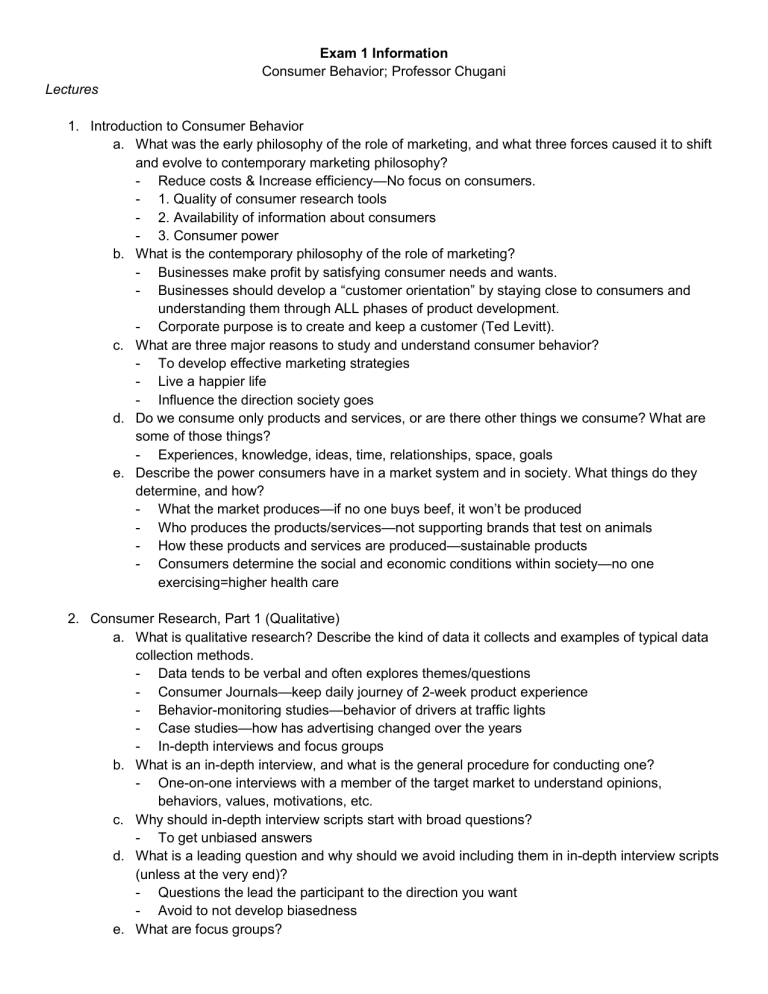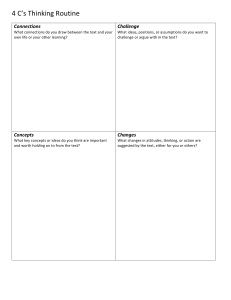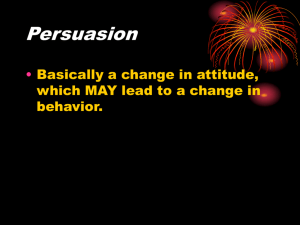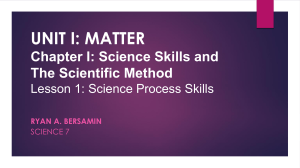
Exam 1 Information Consumer Behavior; Professor Chugani Lectures 1. Introduction to Consumer Behavior a. What was the early philosophy of the role of marketing, and what three forces caused it to shift and evolve to contemporary marketing philosophy? - Reduce costs & Increase efficiency—No focus on consumers. - 1. Quality of consumer research tools - 2. Availability of information about consumers - 3. Consumer power b. What is the contemporary philosophy of the role of marketing? - Businesses make profit by satisfying consumer needs and wants. - Businesses should develop a “customer orientation” by staying close to consumers and understanding them through ALL phases of product development. - Corporate purpose is to create and keep a customer (Ted Levitt). c. What are three major reasons to study and understand consumer behavior? - To develop effective marketing strategies - Live a happier life - Influence the direction society goes d. Do we consume only products and services, or are there other things we consume? What are some of those things? - Experiences, knowledge, ideas, time, relationships, space, goals e. Describe the power consumers have in a market system and in society. What things do they determine, and how? - What the market produces—if no one buys beef, it won’t be produced - Who produces the products/services—not supporting brands that test on animals - How these products and services are produced—sustainable products - Consumers determine the social and economic conditions within society—no one exercising=higher health care 2. Consumer Research, Part 1 (Qualitative) a. What is qualitative research? Describe the kind of data it collects and examples of typical data collection methods. - Data tends to be verbal and often explores themes/questions - Consumer Journals—keep daily journey of 2-week product experience - Behavior-monitoring studies—behavior of drivers at traffic lights - Case studies—how has advertising changed over the years - In-depth interviews and focus groups b. What is an in-depth interview, and what is the general procedure for conducting one? - One-on-one interviews with a member of the target market to understand opinions, behaviors, values, motivations, etc. c. Why should in-depth interview scripts start with broad questions? - To get unbiased answers d. What is a leading question and why should we avoid including them in in-depth interview scripts (unless at the very end)? - Questions the lead the participant to the direction you want - Avoid to not develop biasedness e. What are focus groups? - Moderator-facilitated discussion with small group of people from target market (or other appropriate group) f. What are some potential issues with focus groups, and how can a researcher address those problems? - There is less time for depth because more people need to voice their opinions - Always conduct more than one focus group/Alternate between who speaks first/Ask participants to jot down thoughts before sharing g. What are the three general steps to analyzing qualitative research data? - Start by finding themes across collected data—Increase objectivity by having at least two different researchers do this independently. Then, researchers come together to compare notes and decide on themes. - Quantify those themes to give more objectivity to the data. Can divide respondents into relevant groups (e.g., by gender, income, customer status, etc.). - Include examples when presenting the data—include quotes from interviews to illustrate the theme, or snippets of audio/video recording. h. Should we take what we uncover from Consumer Research as the absolute truth and rely on it completely? Why or why not? - If not done correctly, marketing research can be completely misleading. - Always use and interpret research findings carefully, acknowledging limitations. - Consumer research reduces uncertainty, it does not predict the future. 3. Consumer Research, Part 2 (Quantitative: Experiments) a. What are the main differences between qualitative and quantitative research? Qualitative—great depth in collecting detailed information - limited breadth due to time consuming and cost causing limited interviews - subjective so susceptible to individual interpretation Quantitative—limited depth with few specific questions - great breadth that can collect data from large sample with more structured process - objective relies on objective measurement so less subjective b. What are the main differences between experiments and observational studies? Experiments—Manipulates independent variable to observe effects on dependent variable - Uses random assignment for different conditions - Used to show causality Observational studies—Observe and record data on variables occurring naturally - No manipulation - Draw conclusions for observed DV&IV based on natural correlation c. What is an independent variable, and what is a dependent variable? Be able to identify them in descriptions of studies. Independent Variable—"Input” The variable you think will predict the dependent variable. Dependent Variable—"Output” The variable you measure which you think should depend on the independent variable. Downstream variable. d. What is random assignment and why is it a powerful characteristic of experiments? - Randomly assigning the roles - Can reduce biasedness e. What are the considerations for sample size when running experiments? - At LEAST 50 people per condition f. What is an experimental confound? Define and give an example. - An extraneous variable (one in which you are not interested) that changes along with the variable you are interested in, preventing you from attributing causation to your variable of interest (i.e., parent involvement influencing more/less time playing video games) 4. Consumer Research, Part 3 (Quantitative: Observational Studies) a. What do I mean when I say that correlations point out average trends, NOT universal rules? Be able to provide examples. - The correlations may not apply to everyone (i.e., a significant correlation between gender and height does not mean that every male is taller than every female) b. If we see that two variables are correlated in an observational study, what are the four reasons why they might be correlated? Be able to come up with examples. c. If we wanted to prove that one variable causes the other, what kind of study would we have to run? d. From your reading, “Understanding any Health Study,” what is considered the “king of all evidence,” and why? - Systematic reviews—look at all research studies for the overall trends/results e. What was the main takeaway from the video “Scientific Studies, Last Week Tonight with John Oliver”? - Hint: Look for scientific consensus. The scientists are the ones who critically analyze studies and know the complexities of the science. I believe we should trust them as our best bet 5. Consumer Attitudes a. What is an attitude, and where does it fall on the scale of types/levels of affect? b. What are two ways of measuring attitudes, and when would you use one over the other? c. Be able to look at a Fishbein Multiattribute table that has product attributes and a consumer’s evaluations and beliefs and do the following: i. Calculate that consumer’s attitude toward the product. ii. Identify which attribute is most vs. least important to the consumer (hint: evaluations will give you this information, and the further away the evaluation is from 0, the more the consumer cares about it). iii. Identify which attribute has the most and least room for improvement (hint: the beliefs will give you this information, and the lower the belief, the more the room for improvement). iv. Determine which attribute the company should focus on improving given the above information (hint: improving the attribute that has the most room for improvement and that is the highest on importance will yield the greatest improvement in the attitude toward the product). 6. Cognitive Dissonance a. What is cognitive dissonance, and what is it caused by? b. What are the three strategies to reduce dissonance? Be able to define them and give examples of each. - Willful Ignorance - Change cognition (change opinion on bad influencing factor) - Rationalization 7. Choice-Based Conjoint and In-Class Assignment: Choice-Based Conjoint a. What does CBC in “CBC Analysis” stand for? - Choice-Based Conjoint—observing consumer natural choices to understand attributes preferences. b. What are the two pieces of information you have to provide to Sawtooth Software in order to run a conjoint analysis? (Hint: you do this in step 1) - Attributes (i.e., size, temp.) and level (i.e., grande, hot) 8. Implicit Attitudes a. What is the difference between an explicit and an implicit attitude? b. When referring to consumer memory, what is an associative network, and what is it composed of? c. What does spreading activation (priming) mean, and what does it cause? d. Where do implicit attitudes come from, and how do links between nodes form? e. Can implicit attitudes be changed? If so, how? f. How do you measure implicit attitudes, and what kinds of things do these attitudes predict? g. When a company experiences negative publicity, what is the best way to deal with the situation and prevent further harm to attitudes? 9. Influencing Attitudes a. What are the two routes of persuasion and what are each of them like? - Central route - Peripheral route/cues—i.e., mood b. When does each route of persuasion occur? c. What do consumers rely on to determine whether to accept or reject a message under each route of persuasion? d. If attitude changes, what is the resulting attitude like under each route of persuasion? e. What is an external/peripheral cue? Understand them all and have examples for each. f. What is mood and how does it relate to emotions and attitudes/evaluations? g. What are mood effects? What is mood congruence? h. When a company uses emotions to persuade consumers, what is the resulting attitude like if the attitude does change? (Hint: You need to know what route of persuasion emotional cues fall under to answer this question). i. In the “real world,” do consumers fall neatly into using either one of the routes of persuasion? 10. Decision Processes a. What factors influence the complexity of a decision-making process? b. What are heuristics? Are they used in relatively low or high complexity decisions? c. What are the nine heuristics we spoke of in class? d. What is the difference between compensatory and non-compensatory processes? e. Are the above processes used on relatively low or high complexity decisions? f. What are the two compensatory processes? Be able to describe how they work. How are they different from each other? g. What are the three non-compensatory processes? Be able to describe how they work. h. Be able to identify the decision process from a description of it. See the lecture slides entitled “Identify the Decision Processes” for examples. Assignments 1. Excel Tutorials a. What are relative and absolute cell references? How do you make a cell reference absolute? Why are absolute cell references useful? - Relative—moves (i.e., labels disappear when scrolling) - Absolute—stays lock (i.e., labels stay when scrolling) 1. What are pivot tables, and what do you use them for? - Summarize large sums of data 2. What is v-lookup, and what do you use it for? - Formula used to combine data across sheets as long as there is a common factor 2. News Assignment: Understand the correct answers for this assignment. The correct answers will be posted in BB under the “Assignments” folder. The following items will NOT be covered on the exam. 1. Lecture: Course Overview 2. Lecture: Mindfulness Exercise 3. Assignment: Mindfulness Exploration 4. Assignment: Professional Development 5. Reading: Laptops are Great 6. Reading: Taking Notes by Hand




